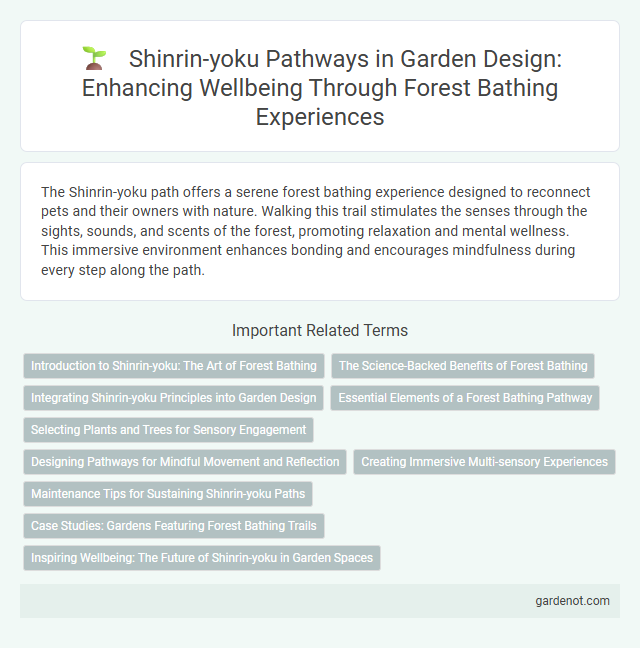The Shinrin-yoku path offers a serene forest bathing experience designed to reconnect pets and their owners with nature. Walking this trail stimulates the senses through the sights, sounds, and scents of the forest, promoting relaxation and mental wellness. This immersive environment enhances bonding and encourages mindfulness during every step along the path.
Introduction to Shinrin-yoku: The Art of Forest Bathing
Shinrin-yoku, or forest bathing, is a Japanese practice that immerses individuals in nature to promote mental and physical well-being. This therapeutic approach encourages slow, mindful walks through lush forest environments, enhancing relaxation and reducing stress. Scientific studies highlight its benefits, including improved immune function and lowered blood pressure, making the Shinrin-yoku path a valuable wellness experience.
The Science-Backed Benefits of Forest Bathing
Forest bathing, or Shinrin-yoku, leverages exposure to natural environments, stimulating the parasympathetic nervous system and reducing cortisol levels, which helps decrease stress and anxiety. Scientific studies reveal that regular walks along a Shinrin-yoku path improve cardiovascular health by lowering blood pressure and enhancing heart rate variability. Immune function also benefits through increased natural killer cell activity, promoting overall well-being and mental clarity.
Integrating Shinrin-yoku Principles into Garden Design
Integrating Shinrin-yoku principles into garden design emphasizes creating immersive sensory experiences through natural elements like diverse tree species, water features, and textured plants to promote relaxation and mindfulness. Pathways are designed to encourage slow, contemplative walking, with varying terrain and strategic seating to enhance connection with nature and stimulate all five senses. The deliberate inclusion of native flora supports biodiversity, fosters ecological balance, and deepens the restorative benefits associated with Shinrin-yoku practice.
Essential Elements of a Forest Bathing Pathway
Shinrin-yoku paths integrate essential elements such as diverse native tree species, natural soundscapes, and smooth, accessible trail surfaces that encourage mindfulness and sensory immersion. The presence of varied flora enhances phytoncide levels, promoting immune system benefits and stress reduction for visitors. Thoughtful design incorporates resting spots and minimal human-made disruptions to maintain tranquility and foster a deep connection with the forest environment.
Selecting Plants and Trees for Sensory Engagement
Selecting plants and trees for a Shinrin-yoku path emphasizes species with diverse textures, scents, and colors to enhance sensory engagement. Native conifers, such as Japanese cedar and hinoki cypress, provide calming aromas, while deciduous trees like maples offer vibrant seasonal hues that stimulate visual senses. Incorporating undergrowth plants like ferns and mosses adds tactile variety, encouraging visitors to connect deeply with the forest environment.
Designing Pathways for Mindful Movement and Reflection
Shinrin-yoku paths are meticulously designed to encourage slow, mindful movement and deep reflection by incorporating natural elements that engage all five senses. Curved trails, varied terrain, and strategically placed resting spots promote physical awareness and mental tranquility, enhancing the therapeutic effects of forest bathing. The thoughtful integration of native flora and subtle soundscapes supports a heightened sensory experience, fostering a profound connection between the individual and the forest environment.
Creating Immersive Multi-sensory Experiences
The Shinrin-yoku path is designed to create immersive multi-sensory experiences by engaging sight, sound, smell, and touch within lush forest environments. Natural elements such as the rustling leaves, earthy scents, and textured bark promote deep relaxation and mindfulness. This holistic sensory approach enhances mental well-being and fosters a profound connection with nature.
Maintenance Tips for Sustaining Shinrin-yoku Paths
Regular pruning of overgrown vegetation and removal of fallen debris ensures safe and accessible Shinrin-yoku paths while preserving the natural ambiance. Implementing soil erosion control measures, such as mulching and installing root barriers, protects the forest floor and maintains trail stability. Periodic inspections and community engagement through volunteer programs help monitor path conditions and promote sustainable forest stewardship.
Case Studies: Gardens Featuring Forest Bathing Trails
Shinrin-yoku paths in gardens emphasize immersive natural experiences, reducing stress and improving mental health through guided forest bathing trails. Case studies such as Japan's Akasawa Natural Recreational Forest and South Korea's Jusanji Forest demonstrate increased visitor well-being and environmental awareness. These gardens integrate native flora with serene walking routes, optimizing sensory engagement and promoting ecological preservation.
Inspiring Wellbeing: The Future of Shinrin-yoku in Garden Spaces
Shinrin-yoku paths in garden spaces offer immersive sensory experiences that promote mental clarity and stress reduction through mindful interaction with nature. Incorporating diverse native flora and strategically designed trails enhances the therapeutic benefits, fostering long-term emotional well-being. Future developments emphasize integrating eco-friendly materials and digital mindfulness aids to deepen the connection between visitors and natural environments.
Shinrin-yoku path Infographic

 gardenot.com
gardenot.com